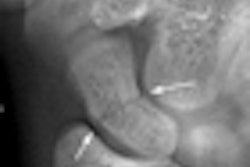
A fully automated algorithm that can extract a respiratory signal from raw PET data has the potential to make gating a more convenient -- and, therefore, more widely adopted -- utility in clinical PET, according to an article published in Medical Physics.
Respiratory gating in PET imaging has the potential to significantly improve spatial resolution when imaging structures in the thorax. By measuring the patient's respiratory motion, image data corresponding to a particular phase in the breathing cycle can be isolated, removing the blurring effects of breathing motion. However, respiratory gating in clinical practice remains uncommon (Medical Physics, October 2010, Vol. 37:10, pp. 5550-5559).
Adam Kesner, PhD, a medical physicist at the International Atomic Energy Agency (IAEA) in Vienna, told medicalphysicsweb: "People have been working on respiratory gating for 10 years, and many even have expensive gating equipment integrated with their scanners ready to use, yet gating is rarely used in clinical PET. We think this is because gating adds complexity to clinical procedures."
Acquiring a respiratory signal for image gating is the key, problematic step. Hardware-based solutions have limitations, including increased scan setup time, the introduction of setup errors, and increased radiation exposure to patients and technologists. Existing software-based approaches only go some way to bypassing these issues. Some are only partially automated, and so still require operator input. Fully automated software is a more attractive prospect, though existing algorithms are a compromise between accuracy and speed.
Kesner and co-researcher Claudia Kuntner, PhD, a medical physicist at the AIT Austrian Institute of Technology in Seibersdorf, identified a need for an algorithm that was both fast and accurate, and would have minimal impact on current imaging protocols, allowing the resolution benefits of respiratory gating to be fully realized in the clinic. Their solution is the sinogram region fluctuation (SRF) method.
The researchers optimized the memory and time required for data processing in several ways. Raw scan data were reduced by truncation and rebinning, and analysis was performed before image reconstruction. Each voxel of data was used to derive a time activity curve, demonstrating the variations in photon activity detected by the scanner. These curves were analyzed, identifying periodic fluctuations lasting two to nine seconds that were likely to result from respiratory motion. Voxels were scored according to the signal strength of the suspected respiratory fluctuations. Filtering removed nonrespiratory fluctuations, and according to each voxel score, the voxel signals were combined to produce a global respiratory signal, representing overall respiratory motion.
SRF accuracy was tested using 22 routine PET chest scans and compared with previously reported algorithms: image voxel fluctuation and geometric sensitivity gating. A hardware-based technique, using a pressure belt fitted to the patient, acted as a measurement standard. SRF scored the highest mean and median Pearson correlation coefficients -- 0.58 and 0.68, respectively -- compared with 0.54 and 0.59 for the image voxel fluctuation algorithm.
SRF processing time for a 10-minute PET scan (using a 2.67-GHz Pentium processor) was approximately 9.2 minutes, compared with 12 hours for image voxel fluctuation and 3.5 minutes for geometric sensitivity gating. Thus, image voxel fluctuation proved to be not far behind SRF in correlating with the pressure belt signal. However, the large difference in processing time reflects the heavy demands of a postprocessing approach, compared to the preprocessing approach used by SRF.
Kesner explained the algorithm's lack of disruption to clinical practice: "If the vendors update their systems to handle the software signal in lieu of the hardware signal, and integrate this into their reconstruction software, the machines can output gated images with no changes to clinical procedures." Potentially, the main obstacle to implementation will be access to the raw image data generated by the PET system. This will require cooperation between vendors and users.
Work on the SRF algorithm is ongoing. Kesner told medicalphysicsweb that "a strong proof of principle has been laid out, and now the question should be about implementation." Among several arms of investigation, Kesner and Kuntner are pushing forward with a study that they hope will show the clinical benefit of using their convenient technique for PET gating.
About the author
Jude Dineley is a medical physicist based in Sydney.
By Jude Dineley
Medicalphysicsweb contributing writer
November 25, 2010
Related Reading
SPIE: Fundamental challenges identified with quantitative PET, April 2, 2010
© IOP Publishing Limited. Republished with permission from medicalphysicsweb, a community Web site covering fundamental research and emerging technologies in medical imaging and radiation therapy.

















